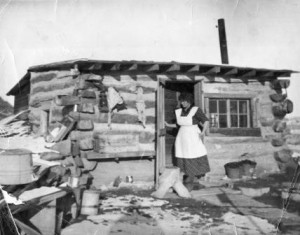
Upon statehood in 1889, 5,600 farms spread across Montana. By 1910, that number had jumped to 26,000. The Enlarged Homestead Act was one reason thousands flooded into Montana, including many married couples. Although federal census records consistently note that women whose husbands were involved in agriculture had no occupations, women were often the linchpins of the family economy and played key roles in building their communities.
Helena Hagadone, Janet Smith, Lilly B. “Ma” Smith, Ruth Garfield, and others represent different experiences, but share a unique sisterhood. What women brought to the marriage influenced the success, and sometimes failure, of the partnership. They were neither as frail nor as frightened as they have sometimes been portrayed.
Frank and Helena Hagadone married in 1913. In 1917, the Hagadones homesteaded with their three children in a hostile place in the Missouri Breaks called the Devil’s Pocket. The Missouri River bottomlands were unbearably hot in summer and cruelly cold in winter. The family grew vegetables and caught fish, but they had no well. They carried river water to the house, let the silt settle, and boiled it for cooking and drinking. Rattlesnakes were everywhere, and one of the children survived a near-fatal bite. After four years, the Hagadones separated. Mrs. Hagadone sent the young girls to board in town and paid for their schooling by working the homestead alone. The girls were glad to leave because their mother had become a mean woman.
Partnerships were sometimes uneven. “I was just like a hired man,” recalled Katie Adams of Hill County. “I was right there. I helped harness the horses and unharness them and hitch them up. And I followed the plow more than once and the harrow and the rake, raked the fields.” Women worked alongside men in haying, threshing, and branding. But they also did the cooking, the washing, and raised the children.
Continue reading The Work Was Never Done: Farm and Ranch Wives and Mothers